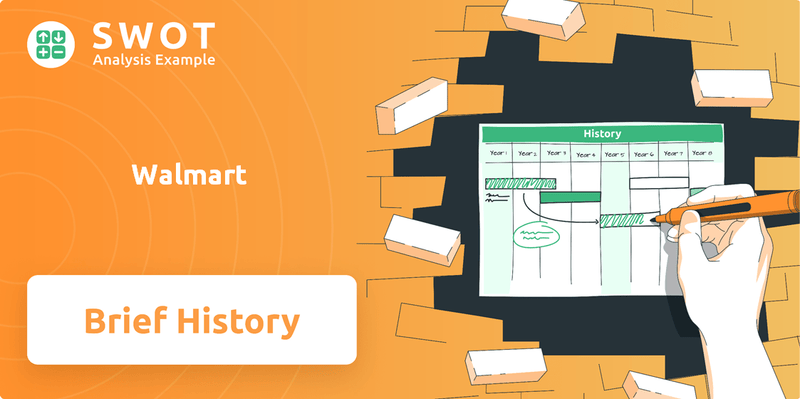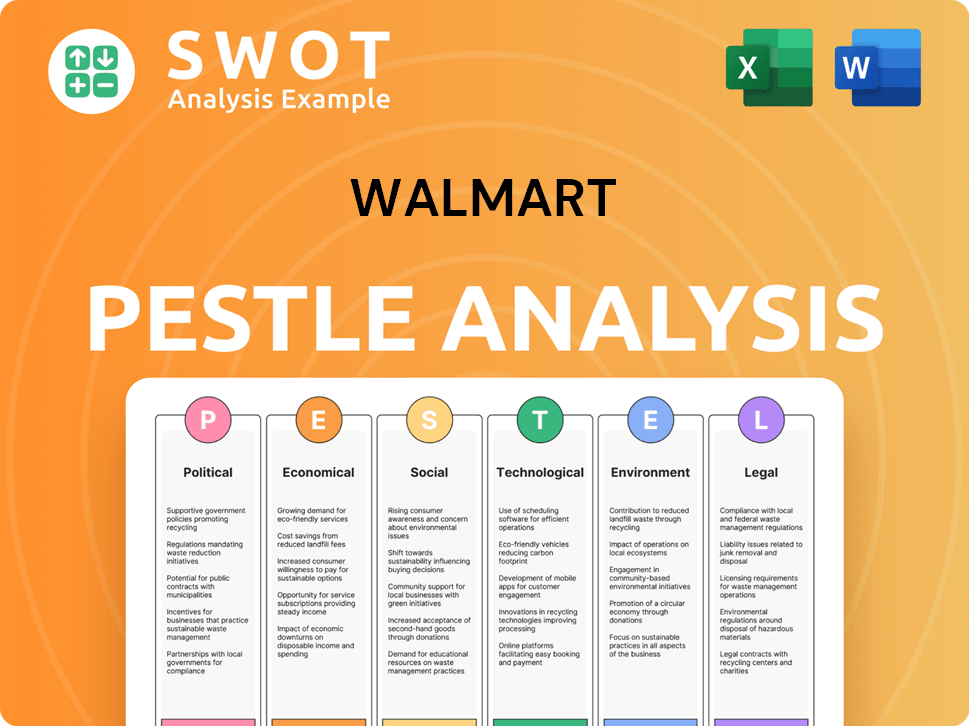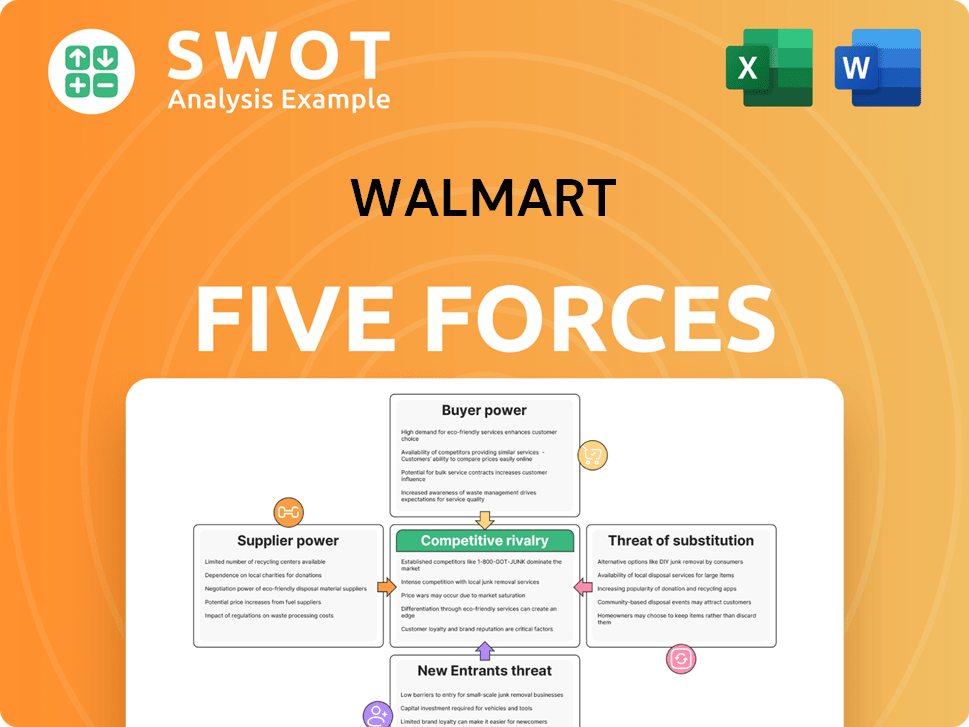Walmart Bundle
How Did Walmart Conquer the World of Retail?
From a single store in Arkansas, Walmart has become a global retail giant, forever changing how we shop. Founded in 1962, the company's mission was simple: bring value to underserved communities. Today, it's the world's largest company by revenue, a testament to its remarkable journey from humble beginnings. This Walmart SWOT Analysis provides deeper insights.

This article delves into the Walmart history, exploring the Walmart origins and the Walmart company's remarkable expansion. Discover how Sam Walton's vision transformed the retail landscape, examining key milestones and the evolution of Walmart's business model. We'll explore its impact on retail, its Walmart growth, and its current market position, offering a comprehensive look at the story of Walmart's success.
What is the Walmart Founding Story?
The Walmart story began on July 2, 1962, when Sam Walton opened the first store in Rogers, Arkansas. This marked the inception of what would become a retail giant, fundamentally altering the landscape of the industry. Walton's vision was to offer low prices and a wide selection of goods, particularly in smaller towns.
With a focus on volume and cost control, Sam Walton created a business model that prioritized customer value. The name 'Walmart' was a simple reflection of its founder and its market focus. Initial funding was secured through personal savings and loans, setting the stage for a retail revolution.
Sam Walton's hands-on approach included visiting other discount stores to learn and improve, driving Walmart's early success. The post-World War II economic boom and suburbanization provided a favorable environment for discount retail formats. To understand more about their target customers, you can read about the Target Market of Walmart.
Here are some key facts about the founding of Walmart.
- Walmart was founded by Sam Walton.
- The first store opened on July 2, 1962, in Rogers, Arkansas.
- The business model focused on discount pricing and high volume.
- Initial funding came from personal savings and loans.
Walmart SWOT Analysis
- Complete SWOT Breakdown
- Fully Customizable
- Editable in Excel & Word
- Professional Formatting
- Investor-Ready Format

What Drove the Early Growth of Walmart?
The early growth of the company, now known as Walmart, was marked by a rapid expansion strategy. Initially, the focus was on small towns in Arkansas and neighboring states. This approach, which placed stores in less populated areas with minimal competition, proved highly successful. By 1967, the company had expanded to 24 stores, generating $12.6 million in sales. This early expansion was driven by a commitment to everyday low prices and an efficient supply chain.
The company's strategy involved opening stores in areas with less competition. This allowed for quicker market penetration and customer acquisition. The focus on everyday low prices was a key differentiator, attracting budget-conscious consumers. Efficient supply chain management further reduced costs, giving the company a competitive edge.
The 1970s were a period of significant growth. The company went public in 1970 and was listed on the New York Stock Exchange by 1972. The company expanded to 125 stores by 1975, with sales reaching $340.3 million. The development of its own distribution centers improved logistics and reduced costs.
The introduction of Sam's Club in 1983, a membership-only warehouse club, was a strategic move. The first Supercenter, combining a discount department store with a full-service grocery, was launched in 1988. These innovations allowed the company to capture a larger share of the retail market. By 1980, the company had achieved $1 billion in annual sales.
Early customer acquisition relied on word-of-mouth and the appeal of consistently low prices. The competitive landscape primarily consisted of smaller, independent retailers and regional discount chains. The company steadily outmaneuvered competitors through its scale and efficiency. The company's success during this period set the stage for its future growth.
Walmart PESTLE Analysis
- Covers All 6 PESTLE Categories
- No Research Needed – Save Hours of Work
- Built by Experts, Trusted by Consultants
- Instant Download, Ready to Use
- 100% Editable, Fully Customizable

What are the key Milestones in Walmart history?
The history of the Walmart company is marked by significant milestones that have shaped its trajectory from a small discount store to a global retail giant. From its Walmart origins to its current market position, the company has consistently adapted and evolved.
| Year | Milestone |
|---|---|
| 1962 | Sam Walton founded the first Walmart store in Rogers, Arkansas. |
| 1969 | The company was incorporated as Walmart Stores, Inc. |
| 1970 | Walmart went public, marking a significant step in its growth. |
| 1980s | Walmart implemented satellite communications, revolutionizing inventory management. |
| 1987 | Walmart became the largest retailer in the United States by sales. |
| 1991 | Walmart expanded internationally, opening its first store in Mexico. |
| 2000 | Walmart entered the Dow Jones Industrial Average. |
| 2016 | Walmart acquired Jet.com, boosting its e-commerce capabilities. |
Throughout its history, Walmart has been at the forefront of retail innovation. The company's early adoption of technology, such as satellite communication, streamlined operations and enhanced efficiency. Furthermore, the 'Every Day Low Price' (EDLP) strategy, introduced by Sam Walton, transformed the retail landscape, setting a new standard for pricing and customer expectations.
In the 1980s, Walmart pioneered the use of satellite communication to connect its stores and distribution centers. This allowed for real-time data sharing, improving inventory management and supply chain efficiency, a key factor in its early success.
Walmart's EDLP strategy, introduced by Sam Walton, focused on offering consistently low prices, attracting a large customer base. This approach forced competitors to adjust their pricing strategies and redefined consumer expectations in the retail sector.
Walmart invested heavily in supply chain management, utilizing advanced logistics and distribution systems. This enabled efficient inventory turnover and reduced operational costs, contributing to its competitive pricing advantage.
To stay competitive, Walmart has invested significantly in its e-commerce platform and omnichannel capabilities. Acquisitions like Jet.com in 2016 helped accelerate its online presence, allowing it to compete with online retailers like Amazon.
Walmart uses advanced data analytics to understand customer behavior and tailor its product offerings. This data-driven approach helps optimize store layouts, product placement, and marketing strategies, improving sales and customer satisfaction.
Walmart has implemented various sustainability initiatives, including reducing waste, promoting renewable energy, and sourcing sustainable products. These efforts align with growing consumer demand for environmentally friendly practices and enhance its brand image.
Despite its successes, Walmart has faced numerous challenges. These include labor disputes, public relations issues, and the rise of e-commerce. The company has also had to navigate supply chain disruptions and adapt to changing consumer behaviors.
Walmart has faced criticism regarding its labor practices, including wages, benefits, and working conditions. These issues have led to legal battles and public relations challenges, impacting its reputation.
The rise of e-commerce giants like Amazon has posed a significant threat to Walmart's traditional brick-and-mortar business model. To compete, Walmart has invested heavily in its online presence and omnichannel retail solutions.
Walmart has experienced supply chain disruptions, particularly during global events, affecting its ability to maintain low prices and meet customer demand. These disruptions have required the company to adapt its logistics and sourcing strategies.
Walmart has faced public relations challenges related to its environmental impact, treatment of employees, and impact on local economies. These issues have required the company to address concerns and improve its public image.
Economic downturns and inflation can impact consumer spending and Walmart's sales. During these times, the company must adjust its pricing and product offerings to maintain its value proposition and attract budget-conscious shoppers.
Walmart must adapt to changing consumer preferences, including demand for sustainable products, online shopping, and personalized experiences. This requires continuous innovation in product offerings, marketing, and customer service.
For more insights into Walmart's strategic moves, consider reading about the Growth Strategy of Walmart. Walmart's journey, from its Walmart origins to its current position, showcases its resilience and ability to adapt in a dynamic market.
Walmart Business Model Canvas
- Complete 9-Block Business Model Canvas
- Effortlessly Communicate Your Business Strategy
- Investor-Ready BMC Format
- 100% Editable and Customizable
- Clear and Structured Layout

What is the Timeline of Key Events for Walmart?
The Walmart company journey, from its Walmart origins as a single store to its current status as a global retail leader, is marked by significant milestones. These events showcase its growth, adaptation, and influence on the retail industry. From its humble beginnings in Rogers, Arkansas, to its expansion across the globe and into the digital realm, Walmart's history reflects a commitment to innovation and customer service. Key moments include the introduction of Sam's Club, the opening of Supercenters, international expansion, and the launch of e-commerce platforms. Walmart's evolution demonstrates its ability to adapt to changing market dynamics and consumer preferences.
| Year | Key Event |
|---|---|
| 1962 | Sam Walton opens the first Walmart store in Rogers, Arkansas, marking the Walmart origins. |
| 1970 | Walmart goes public, trading shares on the New York Stock Exchange. |
| 1975 | Walmart expands to 125 stores with sales reaching $340.3 million, demonstrating early Walmart growth. |
| 1983 | Sam's Club, a membership-only warehouse club, is introduced. |
| 1988 | The first Walmart Supercenter opens, combining general merchandise with a full-service grocery. |
| 1991 | Walmart begins international expansion, opening its first store in Mexico. |
| 1997 | Walmart becomes the largest private employer in the United States. |
| 2000 | Walmart.com is launched, expanding its e-commerce presence. |
| 2002 | Walmart tops the Fortune 500 list for the first time, showcasing its financial success. |
| 2016 | Walmart acquires Jet.com for $3.3 billion, accelerating its e-commerce strategy. |
| 2020 | Walmart introduces Walmart+, a subscription service offering various benefits. |
| 2024 | Walmart announces plans to open 150 new stores and remodel 650 existing stores over the next five years, showcasing its continued investment in physical retail. |
| 2025 | Walmart continues to invest in automation and technology to enhance its supply chain and in-store experience, with a focus on improving efficiency and customer satisfaction. |
Walmart is focusing on strengthening its omnichannel retail capabilities. This includes integrating online and offline shopping experiences. The goal is to provide customers with seamless shopping experiences across all channels, including in-store, online, and mobile. This approach aims to meet the evolving needs of consumers.
The company is investing heavily in technology and automation. This includes automating supply chains and in-store processes to improve efficiency. Walmart is using technology to enhance its supply chain, aiming to reduce costs and improve the customer experience. These investments are key to adapting to the demands of modern retail.
Continued growth in Walmart's e-commerce segment is predicted. This growth will be driven by investments in last-mile delivery and expanding product assortments. The company is working to improve its online presence and attract more customers. This strategy aligns with the increasing demand for online shopping.
Walmart is committed to innovation, sustainability, and providing value to customers. This commitment is reflected in its strategic initiatives and investments. The company aims to offer everyday low prices and convenient access to goods. This approach is adapted for the digital age and a globally interconnected market.
Walmart Porter's Five Forces Analysis
- Covers All 5 Competitive Forces in Detail
- Structured for Consultants, Students, and Founders
- 100% Editable in Microsoft Word & Excel
- Instant Digital Download – Use Immediately
- Compatible with Mac & PC – Fully Unlocked

Related Blogs
- What is Competitive Landscape of Walmart Company?
- What is Growth Strategy and Future Prospects of Walmart Company?
- How Does Walmart Company Work?
- What is Sales and Marketing Strategy of Walmart Company?
- What is Brief History of Walmart Company?
- Who Owns Walmart Company?
- What is Customer Demographics and Target Market of Walmart Company?
Disclaimer
All information, articles, and product details provided on this website are for general informational and educational purposes only. We do not claim any ownership over, nor do we intend to infringe upon, any trademarks, copyrights, logos, brand names, or other intellectual property mentioned or depicted on this site. Such intellectual property remains the property of its respective owners, and any references here are made solely for identification or informational purposes, without implying any affiliation, endorsement, or partnership.
We make no representations or warranties, express or implied, regarding the accuracy, completeness, or suitability of any content or products presented. Nothing on this website should be construed as legal, tax, investment, financial, medical, or other professional advice. In addition, no part of this site—including articles or product references—constitutes a solicitation, recommendation, endorsement, advertisement, or offer to buy or sell any securities, franchises, or other financial instruments, particularly in jurisdictions where such activity would be unlawful.
All content is of a general nature and may not address the specific circumstances of any individual or entity. It is not a substitute for professional advice or services. Any actions you take based on the information provided here are strictly at your own risk. You accept full responsibility for any decisions or outcomes arising from your use of this website and agree to release us from any liability in connection with your use of, or reliance upon, the content or products found herein.